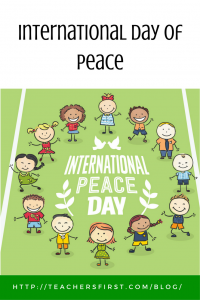 September 21 marks the 36th celebration of The International Day of Peace. Established in 1981 by the United Nations, this annual event intends to provide “a globally shared date for all humanity to commit to Peace above all differences and to contribute to building a Culture of Peace.” This year’s theme is Together for Peace: Respect, Safety, and Dignity for All.
September 21 marks the 36th celebration of The International Day of Peace. Established in 1981 by the United Nations, this annual event intends to provide “a globally shared date for all humanity to commit to Peace above all differences and to contribute to building a Culture of Peace.” This year’s theme is Together for Peace: Respect, Safety, and Dignity for All.
Like adults, students understand best when given an opportunity to compare and contrast their life with those of others around the world. Building awareness of cultural differences helps students develop empathy through an understanding of the world around them.
Last fall I was fortunate enough to travel to Kenya and visit a Masai Mara village. While there, I wished that everyone could have this opportunity. Instead of feeling sorry for people whom we perceive to have less than us, it is eye-opening to connect with individuals who live a different lifestyle yet are content with what they have. The villagers were proud to show us their huts, to show off their adorable children, and tell us about their way of life. My belief is through personal interactions we develop an understanding of others and learn to share common goals of a peaceful existence between people who may be very different in thoughts and lifestyles.
These resources provide an excellent starting point for learning about other cultures and people from around the world on a very personal level.
Social Studies:
- Globetracker’s Mission (Grades 2-6) – Globetracker’s Mission takes 2nd through 6th-grade students on a journey around USA Regions during this school year. Watch for details early in October with the mission starting later that month. Use this mission to learn about different areas of our country, regional geography, and the people that live there.
- If It Were My Home (Grades 3-12) – What would your life be like if you were born in a different country? View comparisons of your living conditions to those in other nations.
- Classrooms Around the World (Grades 2-12) – All students relate to the experience of attending school. This picture gallery shares images from real classrooms around the world. Share this site with students to compare and contrast their school with students in faraway countries.
- Where Children Sleep (Grades 2-12) – This thought-provoking site ties into a book of the same name by James Mollison. Turn the pages to look into the bedrooms occupied by some of the world’s children.
Math:
- Parable of the Polygons (Grades 6-12) – Take a look at how simple choices affect others. Drag and drop polygons as you attempt to move polygons into diverse, yet comfortable neighborhoods. This interactive provides an excellent opportunity for understanding how quickly segregation arises.
Language Arts:
- CurriConnects: Childhood Here and There (Grades preK-12) – This extensive book list from TeachersFirst editors contains collections of books classified by grade levels sharing stories of childhood across many countries and cultures.
- World News (Grades 4-12) – Expand global knowledge with World News. Read top stories from around the world or search for news from a particular region. Photos, global weather, and sports are just a few of the many sections that add to this site’s appeal.
Science:
- bioGraphic (Grades 4-12) – bioGraphic is a stunning multimedia magazine featuring nature and solutions to sustaining life around the earth. Share problems from other cultures and countries with students as part of problem-solving activities. One section is devoted to people around the world and issues faced in developing a more sustainable environment.
All Subjects:
- Peace One Day (all grades)- Sign up with your email address to gain access to resources shared on this site. View and print global education resources for all grade levels available in several different languages. These resources include many hands-on lessons and activities that develop conflict resolution skills and anti-bullying techniques.
Learn about more initiatives for observing The International Day of Peace at their Get Involved section. Take advantage of these many ideas to joining others around the world through the power of sports, the Peace Crane Project, and other global events and programs.
Unfortunately, we can’t all travel the world to learn about other cultures in person. The International Day of Peace provides an opportunity to encourage all of us to learn more about people around the world and the similarities among us. How do you encourage peace and respect for others in your classroom? We would love for you to share your ideas in the comments below.

